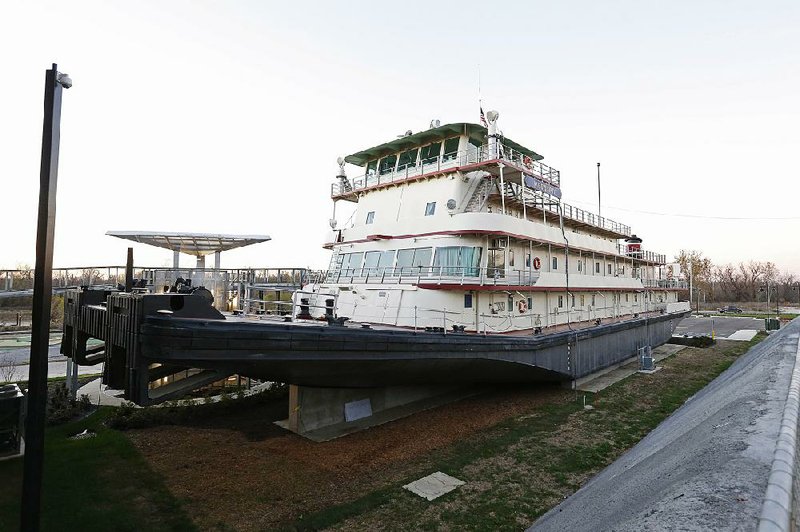VICKSBURG, Miss. — The Lower Mississippi River Museum uses hands-on displays to help people understand the lore and power of the waterway that has shaped North American life for centuries.
The Mississippi and its tributaries drain 41 percent of the U.S. and parts of Canada, comprising the world’s third-largest watershed. The portion called the Lower Mississippi runs about 1,000 miles, from Cairo, Ill., southward past New Orleans.
The museum, on a hill in downtown Vicksburg, opened in August and was built by the U.S. Army Corps of Engineers. So far, it has attracted more than 2,000 visitors each month. Admission is free.
“The only thing we charge people with is that they learn something when they come in,” said museum director Sherry Jones.
The museum features displays about the 1927 flood that deluged 27,000 square miles and displaced more than 160,000 families. Louisiana, Mississippi and Arkansas were hardest hit, and a tent inside the museum shows how people lived after being forced from their homes.
Interactive kiosks offer glimpses into the lives of people who’ve traveled on or lived by the river for centuries. Maps painted on glass show how the river has changed course over the years, and visitors can slide maps over each other to compare the differences. A 1,500-gallon aquarium is filled with catfish and other river creatures.
A small-scale model shows the confluence of two rivers, and visitors can turn faucets to release water in one river at a time or both rivers at once. It’s possible to flood the valley and its miniature buildings.
On an afternoon in mid-December, several employees of the Mississippi Association of Educators toured the museum to explore ideas for school field trips, and the adults played like children.
Terri Rounsaville, who works in Mississippi Association of Educators’ regional office in the northern part of the state, and Jerri McGee, who works in the Jackson office, pressed the screen of an electronic kiosk to learn the stories of a banker, a farmer and a gambler who traveled down the Mississippi River in olden times. They chose different scenarios, with the character traveling in spring or fall, with or without family. In one scenario, a character tried to swim ashore and drowned.
“Awww,” McGee said. “How sad is that?”
Some Mississippi Association of Educators employees rubbed crayons across blank pieces of paper over metal plates with reliefs of a catfish, a rabbit or a snapping turtle. Others laughed while creating a flood in the miniature valley.
“Kids must love these things,” Beverly Brahan, Mississippi Association of Educators’ associate executive director, said to Jones.
“School kids and adult kids,” Jones replied.
The Mississippi River is a water highway that made Vicksburg strategically important during the Civil War, and the museum touches on the 47-day siege that ended July 4, 1863, when Confederate forces surrendered the city and the Union gained control to the vital port.
The muddy river cuts a path through American literature with the works of Mark Twain. Humans have tried to tame the river for decades, with varying degrees of success, and the museum gives information about those engineering efforts.
Visitors can wander through the Motor Vessel Mississippi IV, dry-docked next to the building. From1961 to 1993, the Corps of Engineers used the four-level, diesel-powered towboat for its work, and the Mississippi River Commission used it for twice-a-year river inspections - one week in the spring and one week in the fall. In the pilothouse on the top deck, people can test their skills as a riverboat pilot on a video simulator that’s the same kind used in real training exercises.
The Mississippi River changed its course at Vicksburg in April 1876, cutting across a strip of land called the DeSoto peninsula and leaving the city without a river port. In 1902, the Corps of Engineers diverted the Yazoo River into the old Mississippi River bed near downtown Vicksburg, creating the Yazoo Diversion Canal. The Lower Mississippi River Museum sits near the Yazoo Diversion Canal, not the Mississippi River itself - perhaps a fitting choice for a museum that touts the massive work of the Corps.
Museum employees say it’s no surprise that the building’s construction was delayed when the Mississippi River flooded in 2011, rising near the museum’s perch up a steep hill. During the summer of 2012, the river was so low that barges had trouble traveling up and down the river.
Peggy Dudley, a museum employee and longtime Vicksburg resident, said the museum provides perspective about the Father of Waters.
“You live around here,” Dudley said, “you have a healthy respect for the river.” For more information on the Lower Mississippi River Museum, call (601) 638 -9900 or visit lmrm.org.
Travel, Pages 50 on 01/13/2013

